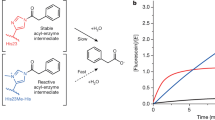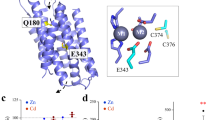Abstract
The ability to redesign enzymes to catalyze noncognate chemical transformations would have wide-ranging applications. We developed a computational method for repurposing the reactivity of metalloenzyme active site functional groups to catalyze new reactions. Using this method, we engineered a zinc-containing mouse adenosine deaminase to catalyze the hydrolysis of a model organophosphate with a catalytic efficiency (kcat/Km) of ∼104 M−1 s−1 after directed evolution. In the high-resolution crystal structure of the enzyme, all but one of the designed residues adopt the designed conformation. The designed enzyme efficiently catalyzes the hydrolysis of the RP isomer of a coumarinyl analog of the nerve agent cyclosarin, and it shows marked substrate selectivity for coumarinyl leaving groups. Computational redesign of native enzyme active sites complements directed evolution methods and offers a general approach for exploring their untapped catalytic potential for new reactivities.
This is a preview of subscription content, access via your institution
Access options
Subscribe to this journal
Receive 12 print issues and online access
$259.00 per year
only $21.58 per issue
Buy this article
- Purchase on Springer Link
- Instant access to full article PDF
Prices may be subject to local taxes which are calculated during checkout





Similar content being viewed by others
References
Toscano, M.D., Woycechowsky, K.J. & Hilvert, D. Minimalist active-site redesign: teaching old enzymes new tricks. Angew. Chem. Int. Ed. Engl. 46, 3212–3236 (2007).
Gerlt, J.A. & Babbitt, P.C. Enzyme (re)design: lessons from natural evolution and computation. Curr. Opin. Chem. Biol. 13, 10–18 (2009).
Khersonsky, O. & Tawfik, D.S. Enzyme promiscuity: a mechanistic and evolutionary perspective. Annu. Rev. Biochem. 79, 471–505 (2010).
Yin, de L.T. et al. Switching catalysis from hydrolysis to perhydrolysis in Pseudomonas fluorescens esterase. Biochemistry 49, 1931–1942 (2010).
Terao, Y., Miyamoto, K. & Ohta, H. Introduction of single mutation changes arylmalonate decarboxylase to racemase. Chem. Commun. (Camb.) 2006, 3600–3602 (2006).
Schmidt, D.M.Z. et al. Evolutionary potential of (β/α)8-barrels: functional promiscuity produced by single substitutions in the enolase superfamily. Biochemistry 42, 8387–8393 (2003).
Leopoldseder, S., Claren, J., Jurgens, C. & Sterner, R. Interconverting the catalytic activities of (βα)8-barrel enzymes from different metabolic pathways: Sequence requirements and molecular analysis. J. Mol. Biol. 337, 871–879 (2004).
Williams, S.D. & David, S.S. A single engineered point mutation in the adenine glycosylase MutY confers bifunctional glycosylase/AP lyase activity. Biochemistry 39, 10098–10109 (2000).
Xiang, H., Luo, L.S., Taylor, K.L. & Dunaway-Mariano, D. Interchange of catalytic activity within the 2-enoyl-coenzyme A hydratase isomerase superfamily based on a common active site template. Biochemistry 38, 7638–7652 (1999).
Park, H.S. et al. Design and evolution of new catalytic activity with an existing protein scaffold. Science 311, 535–538 (2006).
Jochens, H. et al. Converting an esterase into an epoxide hydrolase. Angew. Chem. Int. Edn. Engl. 48, 3532–3535 (2009).
Chen, B. et al. Morphing activity between structurally similar enzymes: from heme-free bromoperoxidase to lipase. Biochemistry 48, 11496–11504 (2009).
Raushel, F.M. Chemical biology: catalytic detoxification. Nature 469, 310–311 (2011).
Gupta, R.D. et al. Directed evolution of hydrolases for prevention of G-type nerve agent intoxication. Nat. Chem. Biol. 7, 120–125 (2011).
Tsai, P.C. et al. Stereoselective hydrolysis of organophosphate nerve agents by the bacterial phosphotriesterase. Biochemistry 49, 7978–7987 (2010).
Murphy, P.M., Bolduc, J.M., Gallaher, J.L., Stoddard, B.L. & Baker, D. Alteration of enzyme specificity by computational loop remodeling and design. Proc. Natl. Acad. Sci. USA 106, 9215–9220 (2009).
Röthlisberger, D. et al. Kemp elimination catalysts by computational enzyme design. Nature 453, 190–195 (2008).
Jiang, L. et al. De novo computational design of retro-aldol enzymes. Science 319, 1387–1391 (2008).
Siegel, J.B. et al. Computational design of an enzyme catalyst for a stereoselective bimolecular Diels-Alder reaction. Science 329, 309–313 (2010).
Zanghellini, A. et al. New algorithms and an in silico benchmark for computational enzyme design. Protein Sci. 15, 2785–2794 (2006).
McCall, K.A., Huang, C. & Fierke, C.A. Function and mechanism of zinc metalloenzymes. J. Nutr. 130, 1437S–1446S (2000).
Aubert, S.D., Li, Y. & Raushel, F.M. Mechanism for the hydrolysis of organophosphates by the bacterial phosphotriesterase. Biochemistry 43, 5707–5715 (2004).
Dyguda-Kazimierowicz, E., Sokalski, W.A. & Leszczynski, J. Gas-phase mechanisms of degradation of hazardous organophosphorus compounds: do they follow a common pattern of alkaline hydrolysis reaction as in phosphotriesterase? J. Phys. Chem. B 112, 9982–9991 (2008).
Kuhlman, B. & Baker, D. Native protein sequences are close to optimal for their structures. Proc. Natl. Acad. Sci. USA 97, 10383–10388 (2000).
Lawrence, M.C. & Colman, P.M. Shape complementarity at protein/protein interfaces. J. Mol. Biol. 234, 946–950 (1993).
Davis, I.W. & Baker, D. RosettaLigand docking with full ligand and receptor flexibility. J. Mol. Biol. 385, 381–392 (2009).
Wang, Z. & Quiocho, F.A. Complexes of adenosine deaminase with two potent inhibitors: X-ray structures in four independent molecules at pH of maximum activity. Biochemistry 37, 8314–8324 (1998).
Pegg, S.C. et al. Leveraging enzyme structure-function relationships for functional inference and experimental design: the structure-function linkage database. Biochemistry 45, 2545–2555 (2006).
Afriat, L., Roodveldt, C., Manco, G. & Tawfik, D.S. The latent promiscuity of newly identified microbial lactonases is linked to a recently diverged phosphotriesterase. Biochemistry 45, 13677–13686 (2006).
Blum, M.M., Lohr, F., Richardt, A., Ruterjans, H. & Chen, J.C. Binding of a designed substrate analogue to diisopropyl fluorophosphatase: implications for the phosphotriesterase mechanism. J. Am. Chem. Soc. 128, 12750–12757 (2006).
Baker, D. An exciting but challenging road ahead for computational enzyme design. Protein Sci. 19, 1817–1819 (2010).
Kunkel, T.A. Rapid and efficient site-specific mutagenesis without phenotypic selection. Proc. Natl. Acad. Sci. USA 82, 488–492 (1985).
Otwinowski, Z. & Minor, W. Processing of X-ray diffraction data collected in oscillation mode. Methods Enzymol. 276, 307–326 (1997).
McCoy, A.J. et al. Phaser crystallographic software. J. Appl. Crystallogr. 40, 658–674 (2007).
Winn, M.D., Murshudov, G.N. & Papiz, M.Z. Macromolecular TLS refinement in REFMAC at moderate resolutions. Methods Enzymol. 374, 300–321 (2003).
Khersonsky, O. & Tawfik, D.S. Structure-reactivity studies of serum paraoxonase PON1 suggest that its native activity is lactonase. Biochemistry 44, 6371–6382 (2005).
Ashani, Y. et al. Stereo-specific synthesis of analogs of nerve agents and their utilization for selection and characterization of paraoxonase (PON1) catalytic scavengers. Chem. Biol. Interact. 187, 362–369 (2010).
Acknowledgements
We thank L. Nivon for assistance with liquid chromatography, O. Khersonsky (Weizmann Institute of Science) for providing substrates and J. Damborsky for comments on the manuscript. This work was supported by the Defense Advanced Research Projects Agency, the Defense Threat Reduction Agency and the Howard Hughes Medical Institute. P.J.G. was supported by Novo Nordisk Danmark-Amerika Fondet and Oticon Fonden.
Author information
Authors and Affiliations
Contributions
S.D.K. developed the computational method for active site redesign, performed computational design and kinetic characterization of PT1–PT12, analyzed the data and wrote the paper. Y.K. designed and performed the directed evolution and library screening, wild-type activity measurements, substrate selectivity and inhibition experiments and analyzed the data and wrote the paper. P.J.G. implemented the computational redesign method, performed the computational design of PT1–PT12 and analyzed the data. R.T. determined the crystal structure of PT3.1. J.L.G. expressed and purified the designed proteins PT1–PT12. Y.S. performed pKa calculations. Y.A., M.G., I.S., H.L. and J.L.S. synthesized nerve agents and nerve agent analogues, screened these with PT3 and determined their stereoselectivity. B.L.S. performed structural analysis and wrote the paper. D.S.T. designed the experiments and analyzed the data. D.B. designed the computational method and the experiments, analyzed the data and wrote the paper.
Corresponding author
Ethics declarations
Competing interests
The authors declare no competing financial interests.
Supplementary information
Supplementary Text and Figures
Supplementary Methods and Supplementary Results (PDF 4626 kb)
Rights and permissions
About this article
Cite this article
Khare, S., Kipnis, Y., Greisen, P. et al. Computational redesign of a mononuclear zinc metalloenzyme for organophosphate hydrolysis. Nat Chem Biol 8, 294–300 (2012). https://doi.org/10.1038/nchembio.777
Received:
Accepted:
Published:
Issue Date:
DOI: https://doi.org/10.1038/nchembio.777
This article is cited by
-
Overcoming universal restrictions on metal selectivity by protein design
Nature (2022)
-
Engineering the protein dynamics of an ancestral luciferase
Nature Communications (2021)
-
Enzymes for amino acid synthesis by design
Nature Catalysis (2021)
-
Enhanced chemoselectivity of a plant cytochrome P450 through protein engineering of surface and catalytic residues
aBIOTECH (2021)
-
Biocompatibility and therapeutic potential of glycosylated albumin artificial metalloenzymes
Nature Catalysis (2019)



